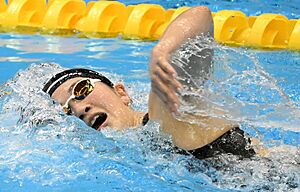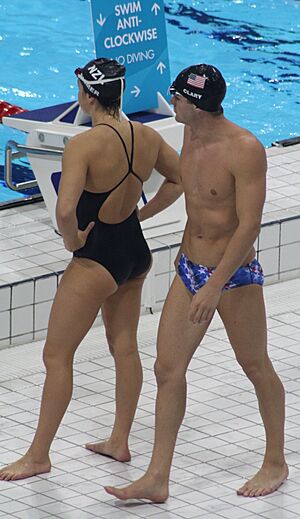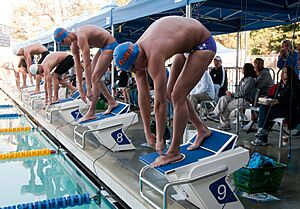Swimming (sport) facts for kids
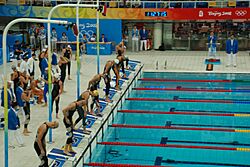
Start of the 4 × 100 meters men's relay during the 2008 Summer Olympics in Beijing
|
|
| Highest governing body | World Aquatics |
|---|---|
| First competitions | 1930s |
| Characteristics | |
| Contact | No |
| Team members | Team or individuals |
| Venue |
|
| Presence | |
| Country or region | Worldwide |
| Olympic | 1896 |
| World Championships | 1973 |
| Paralympic | 1960 |
Swimming is a sport where people use their whole body to move through water. It can be done alone or as part of a team. Swimmers race in pools or in open water like the sea or a lake.
Competitive swimming is a very popular Olympic sport. Swimmers compete in different races using strokes like butterfly, backstroke, breaststroke, and freestyle. There's also the individual medley, which combines all four strokes. In relays, four swimmers work together. A medley relay has each swimmer doing a different stroke: backstroke, breaststroke, butterfly, then freestyle.
Each swimming stroke has special rules about how it should be done. There are also rules about what kinds of swimsuits, caps, and other gear are allowed. Swimming is great for your health! But sometimes, competitive swimmers can get injuries like tendinitis in their shoulders or knees.
Contents
History of Swimming
People have been swimming for a very long time! We've found Stone Age paintings from about 10,000 years ago that show people swimming. Old writings from 2000 BC also mention swimming, like in the Iliad and the Bible. In 1538, a Swiss-German professor named Nikolaus Wynmann wrote the first full book about swimming.
Swimming became a popular sport in England in the 1830s. The first indoor swimming pool, St George's Baths, opened in 1828. By 1837, the National Swimming Society held regular races in pools around London. The sport grew fast. By 1880, when the Amateur Swimming Association was formed, there were over 300 swimming clubs in the country.
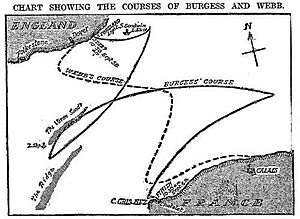
In 1844, two Native American swimmers showed the front crawl stroke to a European audience in London. Sir John Arthur Trudgen learned a similar stroke from South Americans. He used this new stroke in 1873 and won a competition in England. This stroke is still considered very powerful today.
Captain Matthew Webb was the first person to swim the English Channel in 1875. He used the breaststroke and swam about 34 kilometers (21.26 miles) in 21 hours and 45 minutes. No one else swam the Channel for 36 years until T.W. Burgess did it in 1911.
Other European countries also started swimming groups. Germany in 1882, France in 1890, and Hungary in 1896. The first European amateur swimming races were in Vienna in 1889. The world's first women's swimming championship was held in Scotland in 1892.
Men's swimming was part of the first modern Olympic Games in Athens in 1896. In 1902, Richmond Cavill from Australia showed freestyle to the Western world. In 1908, the world swimming group, FINA (now called World Aquatics), was created. Women's swimming joined the Olympics in 1912. The butterfly stroke was developed in the 1930s. At first, it was a type of breaststroke, but it became its own stroke in 1952.
Competitive Swimming Events

Competitive swimming became very popular in the 1800s. The main goal is to swim as fast as possible. Swimmers try to break their own best times or even world records. They also want to beat other swimmers in their race. To swim fast, swimmers need to move through the water with very little resistance.
Professional swimmers train in cycles. They work very hard at the beginning and middle of their training. Then, they reduce their workload as a competition gets closer. This resting period is called "tapering." It helps the swimmer's body recover without stopping exercise completely.
Another part of preparing for a big race is "shave and taper." Swimmers shave off all their body hair. This helps reduce drag in the water, making them feel smoother and faster. It also removes a top layer of dead skin, which can make them feel more sensitive to the water. This can help shave off tiny bits of time from their race.
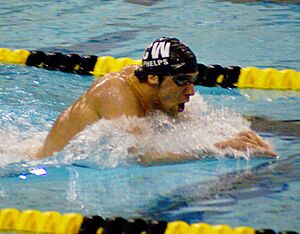
Swimming is a big event at the Summer Olympic Games. Both male and female athletes compete in 16 different events. Olympic swimming races happen in 50-meter pools, which are called long course pools.
There are 40 official individual swimming events in pools. However, the International Olympic Committee only includes 32 of them in the Olympics. The main group for competitive swimming is World Aquatics. It was known as FINA until 2023.
Open Water Swimming
Open water swimming happens in lakes or the sea. These events include races of 5 km, 10 km, and 25 km for men and women. Only the 10 km race is part of the Olympic Games. Pool and open water competitions are usually separate. But they are both part of the World Championships and the Olympics.
Swimming Styles
In competitive swimming, there are four main styles. These styles have stayed mostly the same for the last 30 to 40 years, with only small changes. They are:
- Butterfly
- Backstroke
- Breaststroke
- Freestyle
In most races, swimmers can only use one of these styles. The only exception is the individual medley (IM). In the IM, swimmers do equal distances of butterfly, then backstroke, breaststroke, and finally, freestyle. In the Olympics, the IM is swum in 200-meter and 400-meter distances. Some shorter races, like 100-yard or 100-meter IM, are for younger swimmers or masters swimmers (over 18).
Dolphin Kick
Since the 1990s, the underwater dolphin kick has become very important. Swimmers use it to go faster at the start of a race and after turns. David Berkoff was one of the first to use it well. At the 1988 Olympics, he swam most of the 100m backstroke underwater. He even broke the world record in the first round!
Another swimmer, Denis Pankratov, used this kick at the 1996 Olympics. He swam almost half of the 100m butterfly underwater to win a gold medal. The dolphin kick was not often used in freestyle sprint races until 2008. That's when new "technical" swimsuits were introduced. These suits helped swimmers stay underwater longer.
After this, World Aquatics made a rule. Swimmers can only go 15 meters underwater after a start or turn. In 2014, they also allowed one dolphin kick during the breaststroke pullout. American swimmers like Michael Phelps and Ryan Lochte have used the underwater dolphin kick very well.
Competition Pools
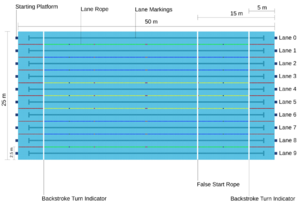
Pools used for World Championships must be 50 meters long and 25 meters wide. They have ten lanes, usually numbered zero to nine. Lanes zero and nine are often left empty in big races. Each lane must be at least 2.5 meters wide. These pools have starting blocks at both ends. Most also have automatic timing equipment, like touch pads. The pool must be at least two meters deep.
Other pools that host World Aquatics events might not meet all these rules. Many have eight or six lanes instead of ten. Some are 25 meters long, which are called short course pools. World records set in short course pools are kept separate. This is because having more turns in a race can be an advantage or disadvantage.
It can be an advantage to swim closer to the center of the pool. This is because of waves made by other swimmers. So, World Aquatics rules decide which lane each swimmer gets based on their past times.
Swimming Seasons
Competitive swimming usually has two main seasons. The autumn and winter season uses short course (25 meters or yards) pools. The spring and summer season uses long course (50-meter) pools and open water.
In international and European club swimming, the short course season is from September to December. The long course season is from January to August, with open water races in the summer. These rules are slowly coming to North America.
In the United States and Canada, the short course (25 yards) season is longer, from September to March. The long course season is from April to August, with open water in the summer. In Australia and New Zealand, the short course season is from April to September. The long course season is from October to March, with open water in the summer.
Outside the U.S., meters are used for both short and long course swimming. In the American short course season, races like the 500-yard, 1000-yard, and 1650-yard freestyle are swum. A yard is shorter than a meter (100 yards is about 91.44 meters). In the American long course season, the 400-meter, 800-meter, and 1500-meter freestyle races are swum.
Starting the season with short course races is good for new swimmers. They can try a new stroke in a 25-yard/meter race. In the long course season, they would need to swim at least 50 meters of that stroke to compete.
Swimming Officials
Many officials are needed to run a swimming competition smoothly.
Referee: The referee is in charge of all officials. They make sure all rules are followed. The referee has the final say on any questions about the meet. They are responsible for the whole event. The referee uses whistles to tell swimmers when to get on the blocks. For backstroke, a long whistle tells swimmers to jump into the water. Another long whistle tells them to grab the gutter. Then, the referee signals the starter to begin the race.
Starter: The starter takes over from the referee. They are in charge of the swimmers until the race begins. The starter says, "Take your mark." Swimmers then get into their starting positions. Once all swimmers are ready, the starter presses a button. This makes a loud sound and a flash of light, starting the race. The starter can call a false start if a swimmer leaves too early. They can also stop the race if something is unfair.
Clerk of Course: The clerk of course gathers swimmers before each event. They organize swimmers into groups called "heats" based on their times. Slower swimmers usually go first. The clerk also notes swimmers who decide not to swim ("scratch") an event.
Timekeepers: Each timekeeper records the time for swimmers in their assigned lane. In most competitions, there are one or more timekeepers per lane. In big international meets with automatic timing, timekeepers might not be needed.
Inspectors of Turns: These officials are at each end of the pool. They make sure swimmers follow the rules for turns, starts, and finishes. If a swimmer breaks a rule, the inspector reports it to the chief inspector, who tells the referee.
Judges of Stroke: Judges of stroke are on the sides of the pool. They watch swimmers to make sure they are using the correct stroke style. They also watch turns and finishes to help the inspectors.
Finish Judges: Finish judges decide the order in which swimmers finish. They also check that swimmers finish correctly. For example, breaststroke and butterfly need two hands to touch at the same time.
If an official sees a swimmer break a rule, they tell the referee. The referee can disqualify (DQ) any swimmer for breaking rules. Swimmers who are disqualified can sometimes challenge the decision. But this is rare in younger age groups.
Swimwear and Equipment
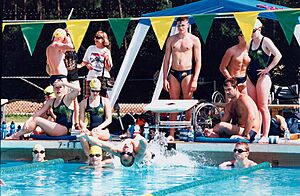
- Swimsuit
- Competitive swimsuits are designed to help swimmers go faster. In 2009, rules changed, and suits made of polyurethane were banned. These suits made athletes float too much. New rules also say men's suits can't go above the belly button or below the knee. Women's suits can't go past the shoulders or cover the neck.
- Swim cap
- A swim cap keeps hair out of the way. This helps reduce drag in the water. Caps can be made of latex, silicone, spandex, or lycra.
- Goggles
- Goggles keep water and chlorine out of swimmers' eyes. Some goggles are tinted for outdoor pools. Swimmers who wear glasses can use prescription goggles.
- Swim Fins
- Rubber fins help swimmers kick faster and build leg strength. They are not allowed in races. Fins also help keep feet in the right position while kicking.
- Drag suit
- Swimmers use drag suits during training. These suits create more resistance in the water. This makes training harder, so swimmers feel less resistance when they race. Drag suits are not used in competitions.
- Hand paddles
- These plastic devices attach to the hands. Swimmers use them to build arm and shoulder strength. They also help improve hand-pulling technique. Paddles come in different shapes and sizes.
- Kickboard
- A kickboard is a foam board that floats. Swimmers hold it to support their upper body while they focus on kicking. Kicking helps build leg muscles.
- Pull buoy
- Pull buoys are made of foam and float. Swimmers hold them between their thighs. They support the legs and prevent kicking. This helps swimmers focus on arm pulling. They can also be used as a kickboard to make kicking harder.
- Ankle bands
- Ankle bands are used to improve balance in the water. They make it harder to kick, forcing swimmers to find better balance.
- Snorkel
- A snorkel is a plastic tube that helps swimmers breathe while their head is in one position. This helps them practice proper breathing technique: breathing in through the mouth and out through the nose. This is different from how runners usually breathe.
Common Swimwear
Popular swimwear brands include Arena, Speedo, and TYR. Polyester is a very durable material for regular swimsuits. Competition swimsuits are tighter and squeeze the swimmer's muscles. Regular swimwear is easier to put on and more comfortable for fun swimming.
Men's Swimwear
For practice, men often wear briefs or jammers. Males usually swim without a shirt.
After the 2008 Summer Olympics in Beijing, there was a lot of talk about new swimsuits. Many Olympic swimmers broke records using full-body suits. In 2008, 70 world records were broken in one year! In some races, the top five swimmers were faster than the old world record.
Because of this, new rules came out on January 1, 2010. Men can only wear suits from their waist to their knees. They can also only wear one swimsuit piece. They cannot wear briefs under jammers.
Women's Swimwear
Women wear one-piece suits for competition. These suits have thicker straps and higher backs. Two-piece suits can be worn for practice. There are different back styles like racerback, axel back, and diamondback. Suits also come in different lengths: three-quarter length (to the knees), regular length (shoulders to hips), and bikini style (two-piece). As of January 1, 2010, women's competition suits cannot go past the shoulders or knees.
Using Drag Wear
Drag suits make it harder to swim. This helps swimmers train for competitions. Other things like nylons, old suits, or T-shirts can also be used to create more drag. This builds strength during training. When these items are removed for a race, swimmers feel faster. Some swimmers practice with basketball shorts over their suit, or wear two suits.
Many swimmers also shave their body hair before big competitions. This reduces friction in the water. This practice became popular after the 1956 Olympics. Murray Rose and Jon Henricks shaved and won gold medals for Australia. Shaved skin is smoother in the water. A study in 1989 showed that shaving helps swimmers perform better by reducing drag.
Using a drag suit too much can sometimes affect a swimmer's stroke. When a swimmer gets tired, their muscles get tired. They might try to use other muscles, which can make their stroke less efficient.
Elite and International Swimming
Elite and international swimming is the highest level of competition. This includes big events like the Olympic Games and the World Aquatics Championships.
Open-Water Swimming
Open water swimming is when you swim outside a regular pool. This usually happens in a lake or the ocean. This sport has become more popular recently. The 10 km open water event was added to the Olympics in 2005. It was first competed in the 2008 Beijing Olympics.
New swimsuits have been developed that are very fast. Full body suits are now banned. But top swimmers still wear suits that are put together with lasers instead of stitches. Stitches can create drag. These suits can be uncomfortable and tight. They can also tear easily if not handled carefully.
The biggest open water swims, with the most participants, are in Australia. Events like the Pier to Pub and Cole Classic have about 5000 swimmers.
Changes in Swimming Over Time
Swimming times have gotten faster over the years. This is because of better training methods and new technology.
The first four Olympics did not use pools. Swimmers competed in open water like the Mediterranean Sea or the Seine river. A 100-meter pool was built for the 1908 Olympics. It was in the middle of the main stadium. The 1912 Olympics in Stockholm Harbor were the first to use electronic timing.
Male swimmers wore full-body suits until the 1940s. These suits caused more drag than modern swimwear. Today's competition suits use special fabrics and designs to reduce drag. This helps swimmers feel less tired. Pool designs have also changed to reduce drag. Things like proper pool depth, wide lanes, and special lane lines make pools "faster."
Starting blocks have also changed a lot. They used to be small and narrow. Now they are bigger, wider, and angled towards the pool. Modern starting blocks also have a "wedge." This is a raised platform at the back. It helps swimmers push off faster and more powerfully with their back leg.
The 1924 Summer Olympics were the first to use the standard 50-meter pool with marked lanes. In freestyle, swimmers first dove from the pool walls. But diving blocks were added at the 1936 Summer Olympics. The tumble turn was developed by the 1950s. Goggles were first used in the 1976 Olympics.
Techniques also changed in the late 1900s. Breaststrokers can now dip their heads completely underwater to glide. This allows for a longer, faster stroke. But they must bring their heads up at the end of each stroke cycle. Also, breaststrokers can now do one butterfly kick off the start and turns. This helps them gain speed. This rule became official in December 2014. Backstrokers can now turn onto their stomachs before the wall to do a "flip-turn." Before, they had to reach back and flip.
Swimming Records
When FINA was started in 1908, they began keeping the first official world records in swimming. Back then, records could be set in any pool that was at least 25 yards long. Today, world records are only accepted if times are recorded by automatic timing equipment.
Some older record events, like 300-yard and 1000-yard freestyle, were removed from the official list in 1948 and 1952. In 1952, the United States and Japan suggested keeping records separate for long-course and short-course pools. But it took four more years for this to happen. Only records from 50-meter pools became the official world records.
By 1969, FINA recognized world records in 31 events. This included 16 for men and 15 for women. This was similar to the events in the Olympic Games.
Electronic timing became much more accurate. So, from August 21, 1972, times were recorded to the hundredths of a second.
Until 1991, world records in short course (25m) pools were called "world best times." They were not official "short course world records." On October 31, 1994, times in 50m backstroke, breaststroke, and butterfly were added to the official record lists.
World Aquatics now recognizes world records for men and women in these events:
- Freestyle: 50 m, 100 m, 200 m, 400 m, 800 m, 1500 m
- Backstroke: 50 m, 100 m, 200 m
- Breaststroke: 50 m, 100 m, 200 m
- Butterfly: 50 m, 100 m, 200 m
- Individual medley: 100 m (short course only), 200 m, 400 m
- Relays: 4×50 m freestyle relay (short course only), 4×100 m freestyle, 4×200 m freestyle, 4×50 m medley relay (short course only), 4×100 m medley
- Mixed relays (teams of two men and two women): 4×50 m mixed freestyle (short course only), 4×100 m mixed freestyle (long course only), 4×50 m mixed medley (short course only), 4×100 m mixed medley (long course only)
Health Benefits of Swimming
Swimming is a great activity for people of all ages. It's a low-impact workout, meaning it's gentle on your joints. Swimming helps build endurance, muscle strength, and a strong heart. It can also help with weight loss. It's a safe way to exercise if you're injured or pregnant. Swimming often feels easier than other sports but still gives you great physical benefits.
The U.S. Census Bureau says that swimming for two and a half hours a week can lower your risk of long-term illnesses. It can also help your body make healthy cells. Swimming is linked to better brain function. It can also lower your risk of Type II diabetes, high blood pressure, and stroke. It makes your lungs and heart stronger and tones your muscles for a full-body workout. You can usually exercise longer in water than on land without feeling as tired. Being in water reduces pressure on your joints.
Besides physical benefits, swimming can also lower stress. It can help with feelings of sadness and worry. Swimming is like a meditation sport. It increases blood flow to the brain, helping you handle stress more calmly. For people with memory problems, swimming can reduce anxiety. It also offers chances to meet people and feel good about yourself.
Common Swimming Injuries
One common injury for swimmers is overuse of the rotator cuff in the shoulder. The rotator cuff is a group of muscles and tendons. When the arm is used repeatedly above the shoulder, these joints can get injured. This happens in all four swimming strokes. The supraspinatus tendon, one of the four, is most likely to tear. Rotator cuff impingement happens when part of the shoulder blade presses on the rotator cuff when the arm is raised.
The best way to prevent injuries is to notice problems early. Poor technique and using a muscle group too much are common causes of injury. Swimmers, coaches, parents, and doctors should talk to each other. This helps find problems before they become serious injuries. Also, proper warm-ups, stretches, and strength exercises should always be done before hard workouts.
If you have a rotator cuff injury, healing takes time. Since muscles and tendons support the joint, the injury must heal completely. This prevents it from coming back. Going back to swimming or other tough exercises too soon can damage the tendon even more. During recovery, focus on strengthening the rotator cuff and shoulder blade muscles.
Another common injury is breaststroke knee, also called swimmer's knee. This injury comes from the kicking movement used in breaststroke. The kicking can cause wear and tear on the knee. This can lead to ongoing pain. Studies show that at first, the pain might only happen during the kick. But eventually, the pain can spread to everyday activities.
See also
 In Spanish: Natación (deporte) para niños
In Spanish: Natación (deporte) para niños
- Diving
- World Aquatics Championships
- Free Colchian
- Georgian swimming
- Lifeguard
- List of swimming styles
- List of water sports
- List of world records in swimming
- Sports nutrition
- Synchronized swimming
- Swimming at the Summer Olympics
- Swimwear and hygiene
- U.S. Masters Swimming
- Water aerobics
- Water polo


